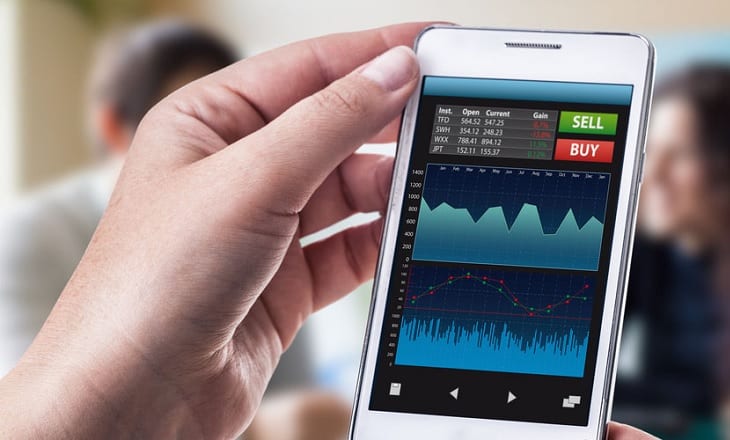The following article was written by Adinah Brown, content manager at Leverate.
While mobile adoption underwent an extraordinary uptick in recent years, for a long time mobile trading continued to lag behind. To the extent that in other interactive consumer industries such as e-commerce or the entertainment industry, the 50% threshold for mobile adoption was broken through in 2011 and then continued on an upward trend to around 70%. Yet in the same time period, mobile trading adoption stagnated at the 30% mark.
To be accurate, a limited number of brokers were able to go over a 50% adoption rate. However, these were unique brokers who were distinctly technologically oriented and were therefore predisposed to promote mobile use amongst their traders. For the most part however, the majority of online trading brokers had a mobile adoption rate which lagged far behind that observed generally in other industries.
Numerous theories have been conjectured to explain this phenomenon. There was the perception of traders that mobile just didn’t offer the same sense of security to the ‘closed-off’ feeling of a desktop. Others, speculated that traders were reluctant to pick up mobile trading due to the lack of analysis capabilities. The small screen that is inherent to a mobile implies that it simply can’t offer the flexibility of a desktop. With its multi-screen analysis capabilities, desk-top is perceived to provide a much richer experience with indicators, annotators and the availability of expert advisers.
Despite these perceived hurdles, industry experts have found that mobile trading is finally on an upward trend, with adoption rates that are consistent with other interactive consumer industries, and with every indication of becoming more prolific than web trading. The changing nature of the typical trader, who on becoming more familiar with using their phone for other functions, has become more comfortable with using their phone to trade the markets. The undeniable appeal of the phone is that it’s more fun and engaging to use whilst also incredibly convenient, whether a trader is in a lift, in a taxi or standing in a que, the opportunity to trade is perpetually available.
This leads one to think that it was perhaps not technical issues that were the source of resistance as much as a reluctance by brokers to promote mobile trading platforms. It was the experience of Leverate, a software development company servicing the technology needs of brokers in the financial trading industry, to hear their clients typically say that they were interested in offering a mobile platform but felt they don’t have the capacity, nor the budget to promote a mobile campaign. The expense of promoting two campaigns, one mobile and one web, significantly increases a broker’s CPA, without any reason to think it will produce an increase in the ROI. For small and medium size brokers running additional media campaigns to push a new frontier of mobile trading can mean a significant stretch on resources.
As existing traders are becoming increasingly aware that they can trade on mobile, they have the freedom to shop around for a more technologically advanced brokerage which has both the means to convert and retain traders more easily, whilst provide traders with the convenience and fun that they’re after. To address the concerns of brokers, Leverate tries to synthesize a push from the web application to the mobile application and thereby facilitate a smoother adoption rate.
According to Leverate’s industry experts, the number of unique sessions on their trading platform, in a ratio of mobile to web visits went from 1:4 to almost 1:1 over the course of a 12 month period. This rate of mobile adoption was even more astounding when you consider the rate of total sessions that includes returning users. After what appeared to be a transition period in January of this year, mobile overtook web as the most frequently used device for trading, so that an inverse development occurred where mobile overtook web at a ratio of 4:1.
These results of total sessions being higher than unique sessions is consistent with expected trader behavior. A trader is likely to explore a new platform and its capabilities on a desk top computer and then, if they choose to continue using it, return on a mobile to execute their trades, see if their triggers were hit, check their trading P&L and account financial status. This is reflected in engagement behavior where the most common page visited is the user’s account summary and the typical duration of a visit is no longer than three minutes. A striking confirmation that mobile trading is used and sought after for its convenience.
Despite this distinct uptick in mobile trading adoption, that’s not to say that trading analytics and strategy restrictions are not an issue, but it’s a factor that only affects traders in the marketing tail. Industry experts anticipate that only a margin of two to five percent of traders will demand analytic tools that are too sophisticated to put on a mobile platform and may continue to trade exclusively on a web trader. The far majority of traders are satisfied with the analytic and strategy tools that are available on a mobile device. But even more so than this, the simple layout of a mobile trading app has its advantages as it appeals to the bulk of traders who find it is easier to use. The beginner and even intermediate trader, can become overwhelmed by the complexity of the desktop platform, where upon being inundated with options, they are deterred from further engagement.
Most traders are engaged in a trading platform to have fun and make a bit of profit. At this level of trading, advanced charting available on the web has the potential to be more of a detriment than a benefit. Rather, the key is simplicity and accessibility, which is exactly what mobile trading offers. In this new age of trading, mobile adoption is a critical trend that brokers simply can’t afford to ignore.
